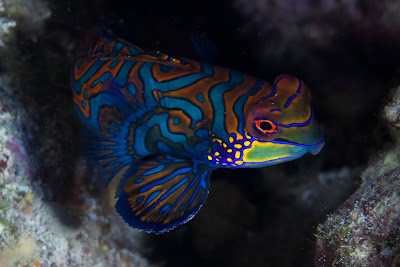The mandarinfish
or mandarin dragonet (Synchiropus splendidus), is a small, brightly
colored member of the dragonet family, which is popular in the saltwater
aquarium trade. The mandarinfish is native to the Pacific, ranging
approximately from the Ryukyu Islands south to Australia.
Description
Synchiropus
splendidus is one of only two vertebrate species known to have blue colouring
because of cellular pigment, the other being the closely related psychedelic
mandarin (S. picturatus). The name "cyanophore" was proposed for the
blue chromatophores, or pigment-containing and light-reflecting cells.
Mandarin
fish are distinctive due to their unusual shape and intense coloration. They
have a broad, depressed head and are primarily blue with orange, red, and
yellow wavy lines. Mandarin fish are small, reaching a maximum length of 6 cm.
Males are notably larger than females. Mandarin fish lack scales and instead
have a thick mucus coating that has an unpleasant smell. They have 4 dorsal
spines, 8 dorsal soft rays, and no anal spines. In males, the first dorsal
spine is greatly elongated, sometimes long enough to reach the caudal peduncle.
Distribution and Habitat
Mandarinfish
are shy and mostly passive. Normally they are found inhabiting broken coral
rubble beds or under dead coral. They are so shy that any heavy breathing or
movement will scare them away back to their shelters. They are usually found in
groups or in pairs on reef crests and slopes in sheltered lagoons throughout
much of the Western Pacific and in the Coral Triangle of biodiversity, which
includes Malaysia, Indonesia, the Philippines and Australia.
Reproduction
Just
before the sun sets, 3 to 5 females will make their way to a particular region
of the reef and gather where males visit and display courtship behaviour,
hoping to attract the females. The visiting males may tour around various sites
in one evening spreading their sperm among a number of different females. Lucky
guys J!
A
successful male will then be joined by a female that will rest on his pelvic
fin. The male and female mandarinfish will align themselves belly-to-belly and
together, slowly rise about 1 meter above the reef. Once they are at the peak
of their ascent, they will release sperm and a cloud of eggs (usually up to 200
eggs). The fish then disappear in a flash. The fertilized eggs are from that
point at the mercy of the current and normally take around 18-24 hours to hatch
into 1 mm long larvae. For a period of up to 2 weeks, they will remain plankton
with no parental involvement before finally settling on the reef and choosing
an appropriate habitat where they will live for the next 10 to 15 years.
With
only a small number of active females in a group's population, competition
among the males is high. In the world of mandarinfish, size does matter! The
bigger and stronger males tend to be favoured by females and mate more often
than smaller males. Due to the lower chances of mating, the smaller males have
developed a rather desperate compensating measure. They are known to rush up to
mating pairs and release sperm with the hope of random fertilization.
For
any semi-serious diver, this unique mating ritual is certainly a must-watch
event. It is known that mating occurs for several months each year, so there
are no excuses for not having a ringside seat at this most intimate of
displays.
Development
Mandarin
fish have a short incubation time and larvae that are small and develop
quickly. Clutch sizes range from 12 to 205. Eggs measure from 0.7 to 0.8 mm in
diameter, are colorless, spherical, and pelagic. The eggs at first are clumped
together and then slowly break up into smaller units. The eyes become pigmented
and the mouth becomes well developed 36 hours after fertilization. During the
flexion stage, which occurs after 8 to 11 days, the caudal fins become
distinctive, the pelvic fin rays move distally and the body becomes robust. The
larvae are active and feeding at this stage. After 12 to 14 days, which is the
settlement stage, juveniles look like the adults with a large head, and a
triangular shaped body. In 18 to 21 days, the body darkens to an orange brown
color with greenish banding and the dorsal spines are observed. The adult color
pattern does not develop until the second month when lengths are from 10 to 15
mm. The swim bladder is retained in adults
Predation
Mandarin
fish secrete mucous which might act to repel predators. The intense coloration
also might play a role in avoiding predation by signalling to potential
predators that they are toxic. Early development could possibly be an adaptive
strategy to reduce the risk of predation. There is no available information on
specific predators of the species.
Some scientist
reported that the mandarinfish contains two types of secretary cells in its
colourful epidermis - one that produces a thick mucus coating to protect it
from the elements, and another that produces a toxin to protect it from
predators. And not only is this toxic mucus coating dangerous, particularly if
it makes it into a predator's open wound, but reportedly, it smells disgusting.



No comments:
Post a Comment